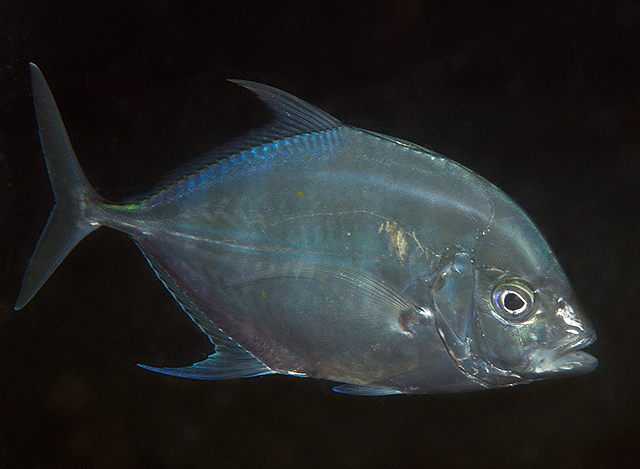| Carangidae (Jacks and pompanos), subfamily: Caranginae |
| 41 cm TL (male/unsexed) |
|
reef-associated; marine; depth range 1 - 60 m |
| Indo-West Pacific: East Africa to Samoa (Ref. 592) and Tonga (Ref. 53797), north to Japan, south to Australia (Ref. 3197) and New Caledonia (Ref. 9070). |
|
Dorsal spines (total): 8-9; Dorsal soft rays (total): 20-23; Anal spines: 3-3; Anal soft rays: 16-20. This species is distinguished by the following characters: D1 VII-VIII, D2 I,20-23 (usually 22 or 23); lobe of second dorsal fin filamentous in young, becoming shorter with age, in mature adults distinctly shorter than head length (larger than 25 cm fork length, height of second dorsal-fin lobe usually shorter than head length, and slightly to distinctly shorter than anal-fin lobe); A II + I,16-20; gill rakers including rudiments 5-8 + 15-19 = 21-27; straight part of lateral line with 16-20 scutes, and 31 to 50 total elements (including anterior scales); breast naked ventrally to distinctly behind origin of pelvic fins; laterally, naked area of breast typically extends diagonally to naked base of pectoral fins (rarely, naked areas of breast and pectoral-fin base interrupted laterally by a narrow band of scales); jaws with bands of villiform teeth, the bands widest anteriorly; in life, bluish green above, silvery grey below; sides with numerous, small yellow spots and a small black blotch on upper margin of opercle; second dorsal, anal, and caudal fins dusky, the latter sometimes yellowish; pectoral fins pale yellow; pelvic fins hyaline to pale grey (Ref. 9894); often with 5 diffuse dark bars (Ref. 90102).
Description: Body strongly compressed, almost ovate, dorsal profile more convex than ventral profile, nape mildly curved. First rays of soft dorsal and anal fins equally prolonged in young, the anal fin becoming longer than the dorsal fin with growth, and both ultimately becoming short (Ref. 559). |
| Adults are found in deep coastal reefs and rarely inshore (Ref 3197). They are usually in small groups over sand bottoms near reefs (Ref. 90102). |
|
Least Concern (LC); Date assessed: 06 March 2015 Ref. (130435)
|
| harmless |
Source and more info: www.fishbase.org. For personal, classroom, and other internal use only. Not for publication.

